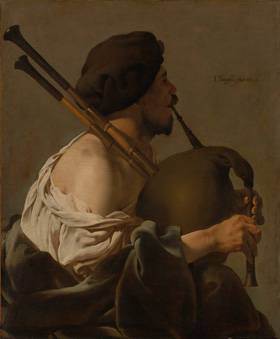
Hendrick Ter Brugghen (1588–1629)
Bagpipe player in Profile, 1624
101 x 83 cm (39 3/4 x 32 5/8 in.)
oil on canvas
National Gallery of Art, Paul Mellon Fund and Greg and Candy Fazakerley Fund
National Gallery of Art acquires “Bagpipe Player in Profile” (1624) by Hendrick ter Brugghen
February 13, 2009 – The National Gallery of Art’s acquisition of Bagpipe Player in Profile (1624) by Dutch painter Hendrick ter Brugghen, made possible with substantial support of Gallery donors Greg and Candy Fazakerley, is a historic addition to the Gallery’s celebrated collection of Dutch painting. This remarkable work will be installed in the Gallery’s Dutch paintings galleries by late spring
]]>
“The Ter Brugghen fills a longstanding gap in our world-renowned collection of Dutch painting. Now we have an outstanding work from the Utrecht Caravaggisti, among the most important and distinctive stylistic artistic groups in The Netherlands in the 17th century,” said Earl A. Powell III, director, National Gallery of Art. “This is one of Ter Brugghen’s most appealing paintings and we are very grateful to longtime Gallery supporters Greg and Candy Fazakerley, who helped us acquire this masterpiece.”
The Artist
Hendrick ter Brugghen (1588-1629) is the most important of the Utrecht Caravaggisti, artists who traveled to Rome in the early decades of the 17th century, and who returned to Utrecht having embraced the radical stylistic and thematic ideas of Caravaggio. Ter Brugghen, who painted biblical and mythological scenes as well as genre paintings, often with figures playing musical instruments, is renowned for the boldness of his images and for the subtle tonalities with which he modeled his forms. His broad style, markedly different from the detailed realism of most Dutch painting of his day, allowed him to create a great sense of dignity and grandeur in his figures. Peter Paul Rubens admired these qualities when he visited Ter Brugghen in Utrecht in 1627 and decreed that Ter Brugghen was the only “real painter” he had met in the Netherlands.
The Painting
Ter Brugghen’s religious and genre scenes resonated with Dutch artists, and his influence was widely felt in Utrecht and beyond. In the Gallery’s recent exhibition, Jan Lievens: A Dutch Master Rediscovered, which is now on view at the Milwaukee Art Museum through April 26, 2009, visitors can see that this Leiden artist learned much from Ter Brugghen, and even adapted a profile image of a musician similar to the Bagpipe Player in Profile in one of his paintings from the 1620s.
The way Ter Brugghen imparts a sense of dignity to his figures is particularly evident in this famous painting, even though the bag-pipes played by the man were associated with the lower class. The silhouetted profile of the figure, his larger-than-life scale, and the broad patterns created by his instrument and clothing are all important components that make this such a powerful and memorable image.
Bagpipe Player in Profile―recently restituted to the heirs of Dr. Herbert von Klemperer by the Wallraf-Richartz-Museum in Cologne, Germany―was recently sold through auction by Sotheby’s in New York and was later purchased by the National Gallery of Art.
Follow us on:
